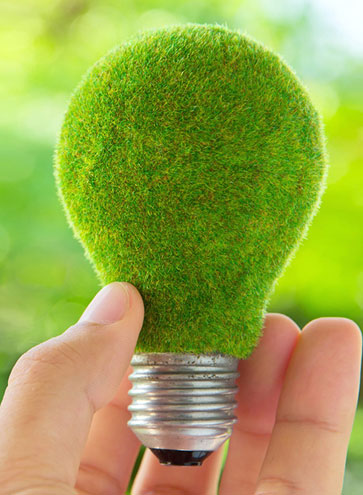What is LED lighting?
LED lights are the latest technology in energy efficient lighting. LED stands for ‘Light Emitting Diode’, a semiconductor device that converts electricity into light. LED lights are super energy efficient, using approximately 85% less energy than halogen or incandescent lighting – meaning significant savings on your power bills. LED lights also have a much longer lifespan than other types of lighting - see the table below.
| Lighting technology |
Estimated lifespan* |
| LED |
25,000-50,000 hours |
| CFL |
8,000-15,000 hours |
| Halogen |
1,000-5,000 hours |
| Incandescent |
1,000 hours |
| *Depending on the globe |
|
How do LED lights work?
LED is a diode that emits light. A diode is a device that allows current to flow in only one direction. Almost any two conductive materials will form a diode when placed in contact with each other. When electricity is passed through the diode the atoms in one material (within the semiconductor chip) are excited to a higher energy level. The atoms in that first material have too much energy and need to release that energy. The energy is then released as the atoms shed electrons to the other material within the chip. During this energy release light is created. The color of the light from the LED is a function of the ingredients (materials) and recipes (processes) that make up the chip.
What are the advantages of LED lights?
As power costs keep on rising, so does the need for us to find more affordable ways to power our homes and businesses. Switching to an LED based light solution helps you saving money; not only through improved energy efficiency, but also through reduced maintenance costs due to LED’s exceptionally longer life. Quite simply, there’s no comparison. As demonstrated below, the costs saving benefits are significant:
- High Luminous Efficiency
- High-levels of brightness and intensity
- Low-voltage and current requirements
- Low heat emission
- High reliability (resistant to shock and vibration)
- Emit No UV Rays or infrared radiation
- Long source life
- Can be easily controlled and programmed
- Low power consumption
- Long life time
- Contain no mercury or lead
- Environmentally friendly – cuts greenhouse gas emissions and reduces landfill.
LED lights are about 30% more energy efficient than CFLs, another form of energy saving lighting, however the main advantage of LED lights over CFLs is lifespan. Depending on the globe, LED lights can last between 30,000 - 50,000 hours, meaning that although LED lights are more expensive to purchase initially, on top of power bill savings, you won’t have to replace the globes nearly as often, making them more cost effective in the long run.
Why are LED lights becoming so popular?
Over the past decade, LED technology has advanced at light speed. In the past, lack of colors and the low intensity made LEDs useful only as indicator lights. As manufacturing methods and technology improved, the LED quickly found homes in more and more applications. These days, the LED is becoming a preferred light source for much more than simple indicators. LED light sources are also gaining popularity due to the growing energy conservation movement. According to the U.S. Department Energy, no other lighting technology offers as much potential to save energy and enhance the quality of our building environments.
Low energy or energy saving lighting is about reducing the wattage used in a light fitting while maintaining similar light output. By using energy saving lighting you can generate huge savings on your electricity bills, and contribute towards building a better environment. And most importantly, energy efficient globes reduce energy consumption and therefore help cut greenhouse gas emissions that are harmful to the environment.
What are the other types of lighting?
- Incandescent globes look like the traditional ‘Edison’ shaped light bulb, with a filament strung across two metal bars in the centre of the globe. These globes were extremely inefficient because they only converted 5-10% of the energy they produced into light, while the remainder was converted to heat. The result was an extreme waste of electricity.
- Halogen globes will look similar to incandescent globes, but it uses an envelope filled with Halogen low pressure Halogen gas to help burn the filament to produce the visible light. In addition, regular 12 volt down lights that have not been changed to energy saving fittings are likely to be halogen. These globes have typically replaced incandescent globes, for example in pendant lights, chandeliers and spotlights.
- CFL (Compact Fluorescent Lamp) – Envirolux: CFLs are fluorescent tubes twisted into shape to fit a standard light fitting. CFLs are about 80% more efficient than incandescent globes but have some restrictions, such as dimming size and the appearance.


